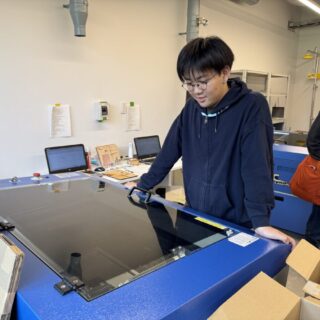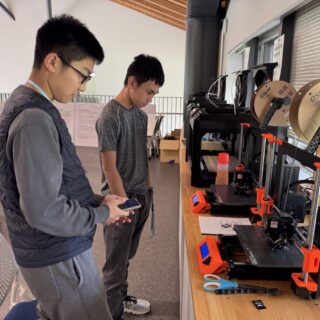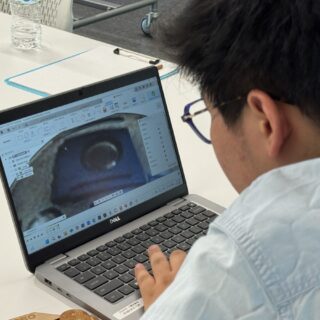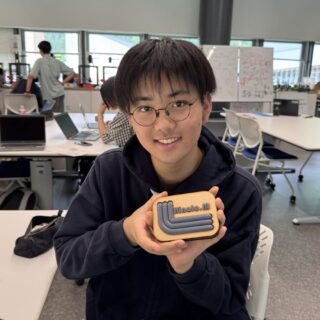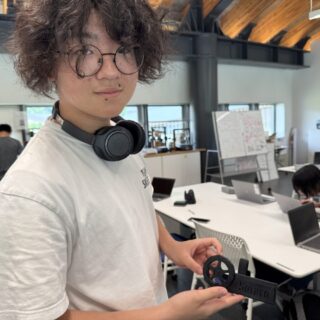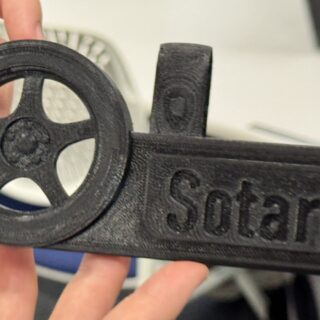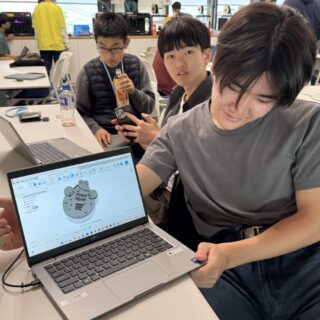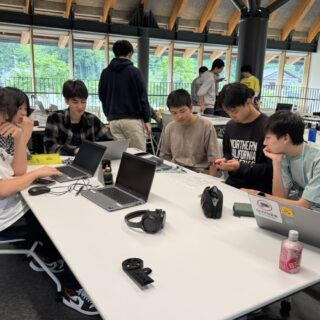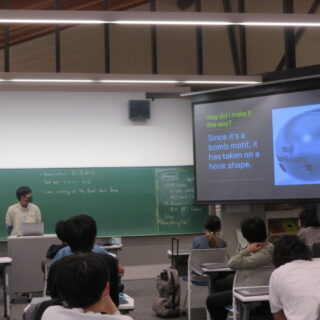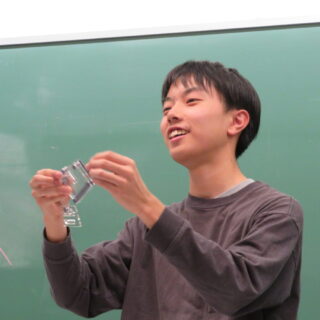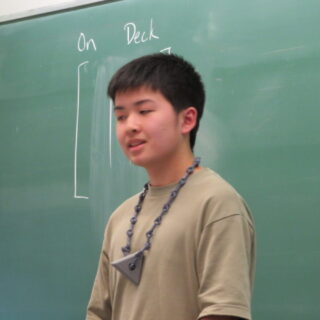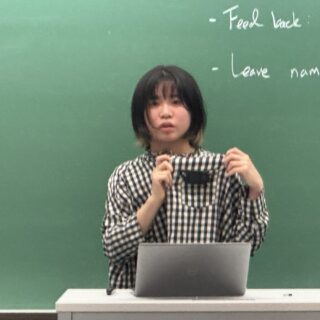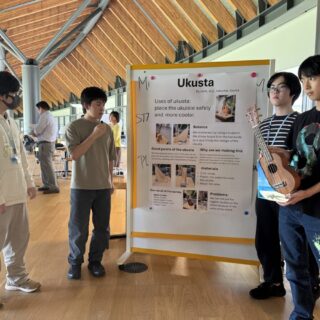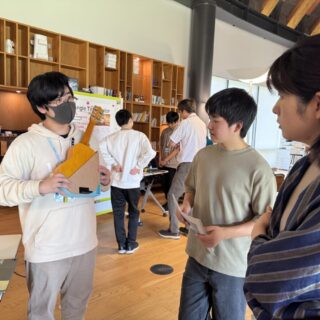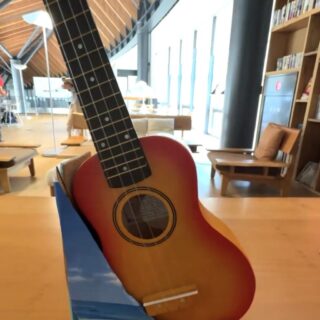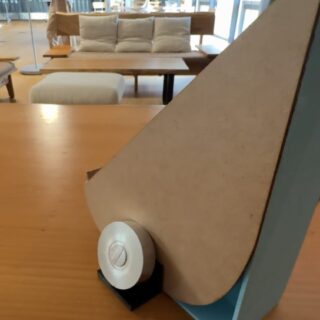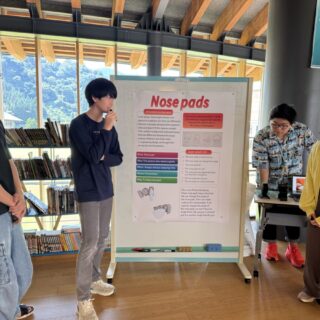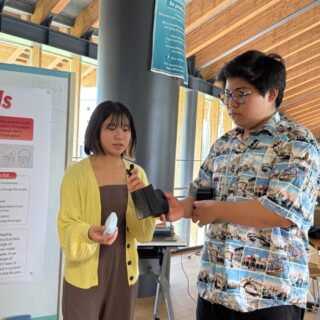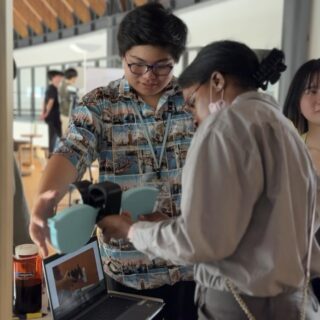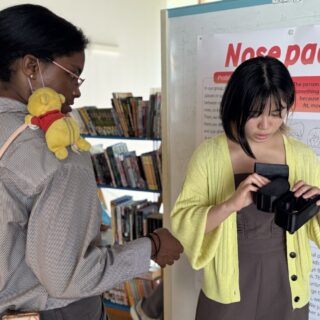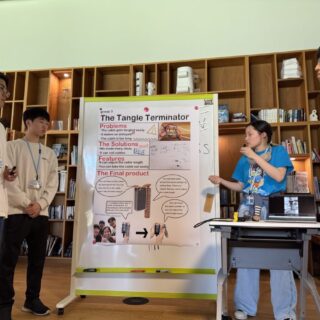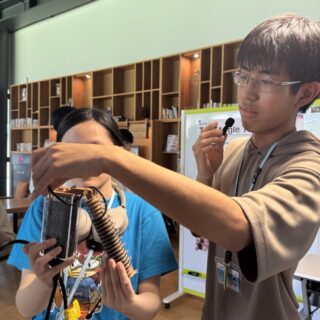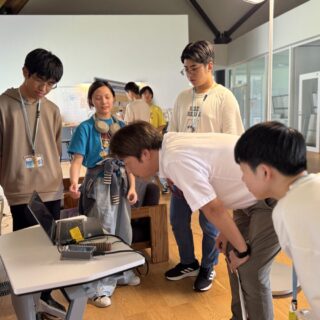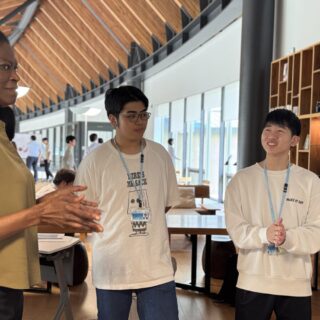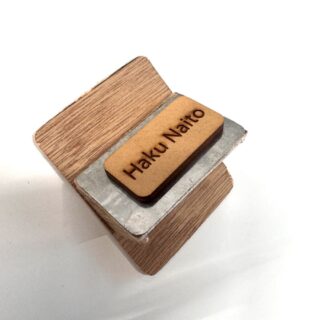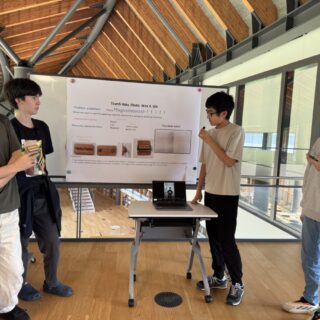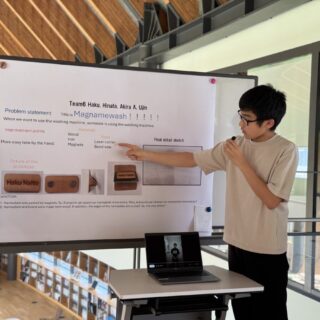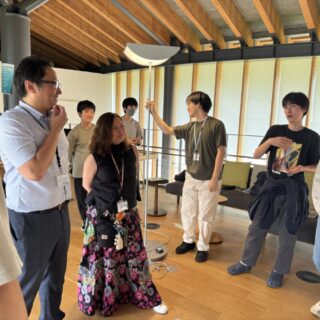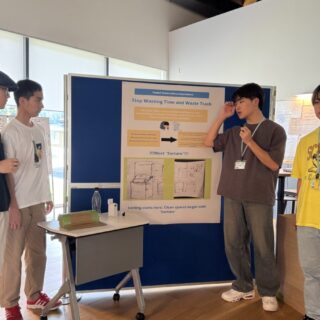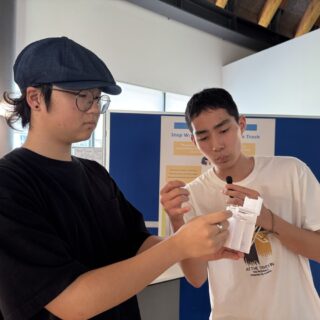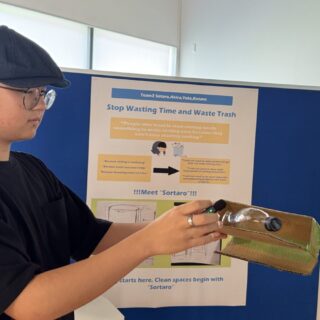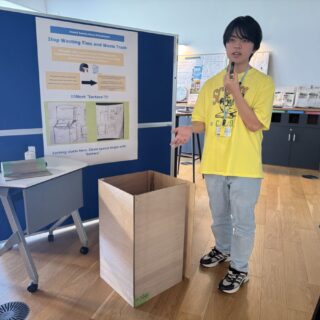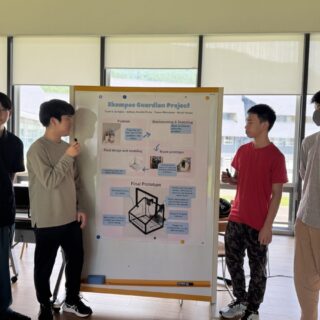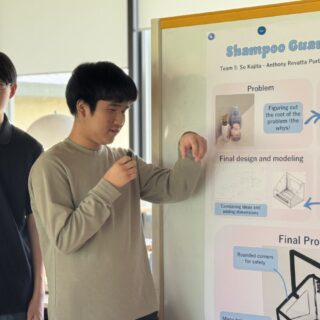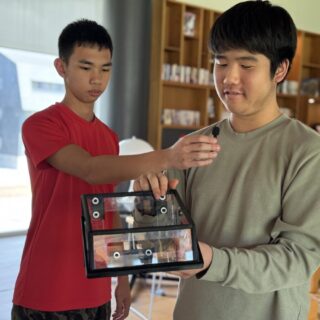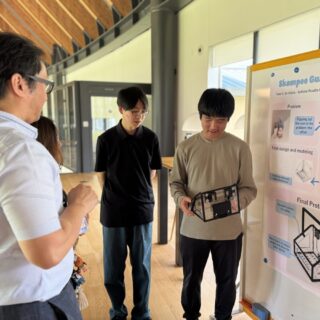1年生エンジニアリングデザイン
プロジェクト1:ネームタグ制作
こんにちは。白山麓キャンパスで1年生のエンジニアリングデザインを担当しているブランドン・ウォルファースです。国際高専のエンジニアリングデザインの授業では、学生たちが多様なプロジェクトに取り組みますが、デザインプロセスへの「導入」として、最初のプロジェクト「個性を表現するネームタグの制作」に挑戦しました。
このプロジェクトにはいくつかの条件がありました。ネームタグは着用可能であること、指定されたサイズ内に収まること、白山麓キャンパスにある3Dプリンターやレーザーカッターを使用して制作すること、そして制作者本人の特徴を視覚的に表現することが求められました。
学生たちはアイデアの発想から始まり、プロトタイピング(試作品作り)を通じて、特徴と機能の関係性について学びました。プロジェクトの締めくくりには、英語でのプレゼンテーションを行い、クラスメートに自作のネームタグを紹介しました。
エンジニアリングデザインの魅力は、テストやクイズとは異なり、問題解決に「唯一の正解」が存在しない点です。学生たちがそれぞれの方法で課題に取り組む様子は非常に興味深く、多くの学生が自身の趣味や好きなメディアをテーマにすることで、作品に個性を反映させていました。これは学生たちにとって初めてのデザイン体験であり、今後の成長が非常に楽しみです。
プロジェクト2:チームによる課題解決
前学期の後半には、1年生はチームプロジェクトにも取り組みました。このプロジェクトの目的は、学生が日常生活を観察し、「毎日使っている中で最も不便なもの」を特定し、それに対する個人的な課題を解決する方法を考案することです。
この活動で特に興味深いのは、学生たちが日常の中でどのような不便さを認識し、それにどう向き合うかという点です。各グループが取り組んだ課題は多様でしたが、共通して求められたのは、「対象物の使用方法の理解」「目的の機能を果たすために必要な特徴の把握」、そして「人間中心の設計の重要性」でした。
以下に、各グループの取り組みをご紹介します。
1. Ukusta(ウクスタ)
このグループは、白山麓キャンパスのリビングコモンズにあるウクレレのための新しいスタンドの設計に挑戦しました。楽器の安定性を高めるとともに、空間の美観を向上させることを目指しました。
2. Nosepads(ノーズパッド)
このグループは、さまざまな眼鏡やサングラスに対応できる調整可能なノーズパッドの開発に取り組みました。鼻の形状に合わせてフィットするよう設計されており、試作品はサイズの関係上、拡大モデルでの提示となりました。
3. The Tangle Terminator(タングル・ターミネーター)
このグループは、ノートパソコンの充電ケーブルがバックパック内で絡まりやすいという問題に着目し、収納性を向上させるための整理ツールを考案しました。持ち運びの利便性を重視した設計です。
4. Magnamewash(マグネームウォッシュ)
このグループは、白山麓キャンパスの寮にあるランドリー設備の利用状況を整理する方法を模索しました。誰がどの機械を使用しているかを簡単に把握できる、設置・使用が容易で情報伝達が明確な仕組みを目指しました。
5. Sortaro(ソルタロウ)
このグループは、ごみの分別が複雑で時間がかかるという問題に取り組みました。日本の分別システムに慣れていない人でも使いやすく、適切に分別できる一体型のごみ箱の設計を目指しました。
6. Shampoo Guardian Project(シャンプー・ガーディアン・プロジェクト)
このグループは、寮のシャワー室における収納スペースの不足に着目しました。シャワー中に使用するボトル類を簡単に持ち運び、アクセスできる収納ツールの開発に取り組みました。
後学期に学生たちがどのようなプロジェクトに挑戦するのか、今から非常に楽しみにしています。
ブランドン・ウォルファース
1st Year Engineering Design

Project 1:Creating Name Tags
Hello everyone, this is Brandon Wohlfarth, one of the Engineering Design teachers for the 1st year students. Within our Engineering Design course here at ICT, students get the chance to work on a wide range of projects, but to help “introduce” the students to the design process, their first project was to create individualized nametags.
There were some criteria that the students needed to follow during the project: their nametag needed to be able to be worn, it needed to fit within a certain volume, it needed to be made using the 3D printers and/or laser cutters that we have here at Hakusanroku Campus, and it needed to visually show important characteristics about the designer.
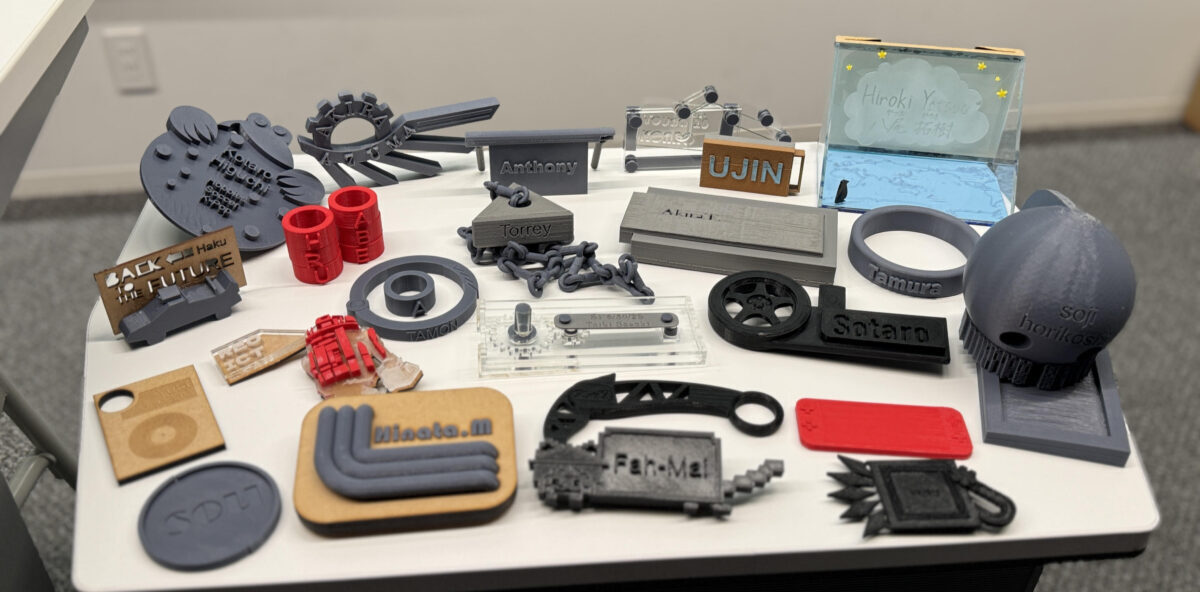 During this project students walked through how to come up with ideas, practiced prototyping, and learned about the connections between features and functions. This project culminated in a presentation where the students were able to “introduce” their nametags to their classmates, and practice their English-speaking skills.
During this project students walked through how to come up with ideas, practiced prototyping, and learned about the connections between features and functions. This project culminated in a presentation where the students were able to “introduce” their nametags to their classmates, and practice their English-speaking skills.
What I enjoy the most about Engineering Design is that, unlike tests and quizzes, there isn’t just one right answer to how to solve the problem. It was very interesting to see how the students decided to approach the challenge ahead of them. Many students focused on creating something that helped introduce their hobbies, or maybe a certain source of media that they enjoyed, allowing them to add parts of their personality into their final creation. This is just the first design experience for the students, so I am looking forward to where they go from here.
Project 2:Solving Problems through Teamwork
Within the first semester the first-year students also worked on a team project in Engineering Design IA. The goal of this project is for students to observe the world around them and identify the “Worst thing that they use everyday” and try to find a solution their individual pain points regarding the topic selected. An aspect of this project that I enjoy seeing is how students perceive and approach different challenges or inconveniences that they experience in their daily life. Each group tackled a very different problem, but they still needed to understand how an object is used, what are important features needed to complete a desired function, and a little about how people are an important part in designing a new product. We always get some interesting projects when we do this activity, so I am excited to share them all with you.
1. Ukusta
This group decided to take on the challenge of designing a new stand for the ukuleles found in the Living Commons at the Hakusanroku Campus. They wanted to make something that would stabilize the instrument while also helping to improve the visual aesthetics of the space.
2. Nosepads
This group decided to devise an adjustable attachment that could fit with various glasses or sunglasses, in order to help match the shape and contour of different noses. Due to the size that this type of attachment would need to be, for demonstration purposes only, their prototype was an enlarged version of their design.
3. The Tangle Terminator
This group decided to envision a way to help organize their laptop charging cables to improve upon its ability to be stored inside of a backpack, as most students do. They found that inside of the backpack, the cables tended to become tangled easily, which lead them to address this issue within the scope of portability.
4. Magnamewash
This group wanted to find a way to help organize the use of the laundry facilities within the Hakusanroku Campus dormitories. They wanted to help solve the issues of not knowing who is using what machine in an easy to install, easy to use way that would transfer information quickly and clearly.
5. Sortaro
This group found that sorting trash can be a difficult and time-consuming activity, and as someone who even after years of living in Japan still has challenges understanding this system I can relate. They wanted to make something that would still properly sort various types of garbage, but be in one easy to use location.
6. Shampoo Guardian Project
This group wanted to address the lack of shelving space within the showers at the Hakusanroku Campus dormitory. They wanted something that could be used within the shower stalls on campus, that was easy to carry and to access the various bottles that they wanted to use while showering.
I am looking forward to what they do in the second semester!
Brandon Wohlfarth









